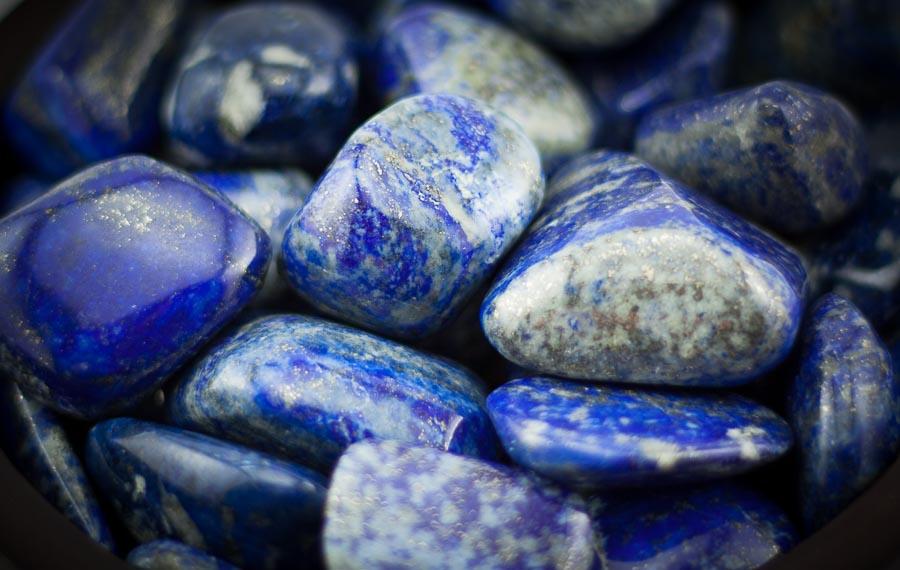You will not be allowed to compare more than 4 products at a time
View compareLapis Lazuli Tumbled 1 lb
Lapis Lazuli Tumbled 1 lb
Estimate delivery times:5-8 days.
Flat Rate Shipping and FREE Shipping on orders more than $100.
About This Product
Lapis Lazuli – The Celestial Blue Stone of Kings
Radiant Blue Splendor
Lapis Lazuli immediately captivates with its rich royal blue hue and shimmering accents of gold. Its color is as deep and enigmatic as a midnight sky, adorned with flecks of golden pyrite that twinkle like stars caught in stone. This ultramarine gemstone exudes an aura of ancient mystique and regality; even the Romans were spellbound by its beauty – Pliny the Elder described lapis lazuli as “opaque and sprinkled with specks of gold”. To gaze upon a polished piece is to feel the echo of antiquity and the allure of luxury intertwined, as if one holds a fragment of the heavens imbued with the soul of royalty.
Historical and Cultural Significance
A Gem of Ancient Civilizations: For millennia, lapis lazuli has been treasured by the great cultures of the world. In Ancient Egypt, it was esteemed above all for its celestial color – a favorite for amulets, pendants, and sacred ornaments. Pharaohs and queens adorned themselves with this stone; in fact, legends say Cleopatra wore powdered lapis as a dazzling blue eyeshadow to enhance her famous beauty. So revered was lapis that it was entombed with kings: inlays of this gem gleam in the golden funeral mask of Tutankhamun, symbolically guiding the boy-king’s soul to immortality. Even older Mesopotamian epics sing its praise – the Epic of Gilgamesh mentions lapis lazuli, and Sumerian and Babylonian rulers carved it into royal seals and lion-headed figurines as a mark of divine favor. From the temples of Karnak to the treasures of Ur, lapis lazuli was a stone of gods and kings, traded over great distances and valued more than riches.
The Renaissance and Beyond: After antiquity, lapis lazuli again took center stage in the Renaissance, not as jewelry but as the most coveted artist’s pigment. Shipped to Europe via Venetian traders, it was ground into ultramarine, a paint so exquisite and costly it was said to be “more precious than gold”. Renaissance masters reserved this heavenly blue for the holiest of subjects – the robes of the Virgin Mary, the angels’ wings, and the twilight skies of their masterpieces all owed their depth to lapis lazuli’s brilliance. Painters like Titian and Vermeer demanded it for its unmatched vibrancy. This enduring legacy – from pharaohs to painters – has cemented lapis lazuli’s cultural status as a timeless emblem of wisdom, power, and beauty across human history.
Spiritual and Metaphysical Symbolism
Beyond its artistic and royal pedigree, lapis lazuli carries profound spiritual symbolism that resonates with healers and mystics. It has long been hailed as a stone of truth – a crystal that illuminates the mind and helps one speak openly from the heart. Mystics believe that lapis awakens our inner vision, expanding intuition and insight as if opening a window to the soul’s knowledge. In crystal lore, it is closely linked to the body’s energy centers: lapis lazuli is said to activate the Third Eye Chakra (Ajna), heightening psychic vision and intuitive wisdom, and to empower the Throat Chakra (Vishuddha), encouraging honest expression and communication. A piece of lapis held or worn on these chakras is thought to unlock clarity of thought and genuine self-expression. Equally celebrated is its protective aura – a talisman of protection believed to ward off negativity and “evil eye” influences. Since antiquity, lapis lazuli amulets have been used to shield the wearer from psychic attacks and harm, bringing instead a sense of deep peace and harmony. It is said to cleanse the mind of illusions and reveal one’s inner truth, cultivating self-awareness, compassion, and confidence. In essence, lapis lazuli’s metaphysical reputation is that of a wise guardian, imparting truthful vision, spiritual insight, and protective strength to those who revere it.
Decorative and Luxury Appeal
Jewels of Royalty: The opulent charm of lapis lazuli has graced the halls of palaces and the cabinets of collectors for centuries. Its luxury appeal is evident in the finest jewelry – from pharaonic pectorals to contemporary high-carat necklaces, the stone’s intense blue provides a stunning contrast when set in gleaming gold or sterling silver. Lapis cabochons and beads, often sprinkled with golden pyrite sparkles, have been fashioned into everything from ancient Egyptian scarab amulets to Victorian signet rings. Indeed, in pharaonic Egypt it was “a favorite stone for amulets and ornaments such as scarabs”, believed to carry the protection of the gods. Throughout history, royals and nobles wore lapis lazuli signifying status and wisdom – it adorned crowns, dagger hilts, and ritual objects, becoming synonymous with royal regalia. To this day, heirloom-quality lapis lazuli pieces – whether a strand of polished Afghan lapis beads or a signet ring inlaid with its azure gem – exude a timeless majesty that enchants collectors and connoisseurs alike.
Opulent Art and Interiors: Lapis lazuli’s grandeur extends beyond personal adornment into the realm of ornamental art and interior design. Master craftsmen have long carved this hard stone into luxurious objets d’art: antique snuff boxes, intricate cameos, and decorative vases carved from solid lapis were prized in the courts of Europe and Asia. Its unmistakable blue also embellishes some of the world’s most lavish interiors. In India, the Mughal emperors adorned the Taj Mahal with lapis lazuli inlay – delicate flowers and arabesques of deep blue stone are set into the white marble walls, a breathtaking union of architecture and gemstone. Across continents, European palaces likewise showcased lapis in their décor; for example, King Ludwig II of Bavaria even had fireplace panels made of lapis lazuli in his Linderhof Palace, adding a flash of azure opulence to his gilded chambers. Such implementations were the ultimate status symbol: only the wealthiest could afford to literally decorate with precious stone. Whether gilding a palace or accenting a modern luxury hotel, lapis lazuli in interiors instantly evokes extravagance and elegance. Polished lapis tiles, tabletops, or inlays infuse a space with rich color and historic grandeur, making any setting feel like a royal sanctuary. In every form – jewelry, artwork, or architectural marvel – lapis lazuli elevates the aesthetic to one of sophisticated splendor, its presence unmistakably luxurious and culturally rich.
Scientific Profile and Characteristics
Even in scientific terms, lapis lazuli fascinates as a unique gemstone. Below is a detailed breakdown of its key characteristics:
-
Hardness (Mohs scale): Approximately 5 to 6, meaning lapis lazuli is moderately hard but softer than many gemstones (it can be scratched by harder stones or metals). Care in handling and wearing is advised to preserve its polished finish.
-
Composition: Not a single mineral but an aggregate rock composed chiefly of the blue silicate lazurite, along with white calcite and metallic pyrite inclusions. Minor minerals like sodalite, diopside, or amphibole may also be present, but lazurite is what imparts the signature color.
-
Crystal System: Lapis lazuli as a whole is a rock, but its primary component lazurite crystallizes in the isometric (cubic) system. Well-formed crystals are rare; lapis is usually found in massive granular form within limestone.
-
Luster: When polished, it exhibits a waxy to vitreous luster. High-quality lapis takes on a glossy sheen, while lower grades might appear dull or greasy. The stone is opaque (not transparent), though thin slabs can be slightly translucent at the edges.
-
Primary Sources: The finest lapis lazuli has traditionally come from Badakhshan, Afghanistan, mined for over 6,000 years in the famed Sar-i Sang mines. Other important sources include the Andes Mountains of Chile and the Lake Baikal region of Siberia (Russia). Smaller deposits are found in Pakistan, Angola, Myanmar, Canada, and the USA (Colorado). The Afghan material, with its intense ultramarine color and sparse pyrite, remains the most sought after in the world.
-
Distinguishing Features: The stone’s intense deep-blue color (often called “lapis blue”) with sparkling golden flecks is unmistakable. These brassy flecks of pyrite and occasional white veins of calcite help differentiate genuine lapis lazuli from similar gems like sodalite or dyed marble. Its streak (powdered form) is blue, and it has no cleavage, breaking irregularly (a reminder of its composite nature). Lapis lazuli’s very name reflects its character – derived from lapis (Latin for “stone”) and lāzaward (Persian for “blue”), it literally means “blue stone,” echoing its status as the definitive blue gemstone of antiquity.
Every facet of lapis lazuli – from its storied past to its physical properties – reinforces why it is so beloved. Collectors admire its historical provenance and natural beauty, healers cherish its aura of truth and protection, and lovers of natural luxury prize its opulent color and rarity. In Lapis Lazuli, the earth offers a gemstone that is not only a feast for the eyes but also a treasure for the spirit – a royal blue relic of earth and sky that continues to inspire awe, elevate decor, and whisper ancient secrets to all who hold it.
Sub total:
$55.49





